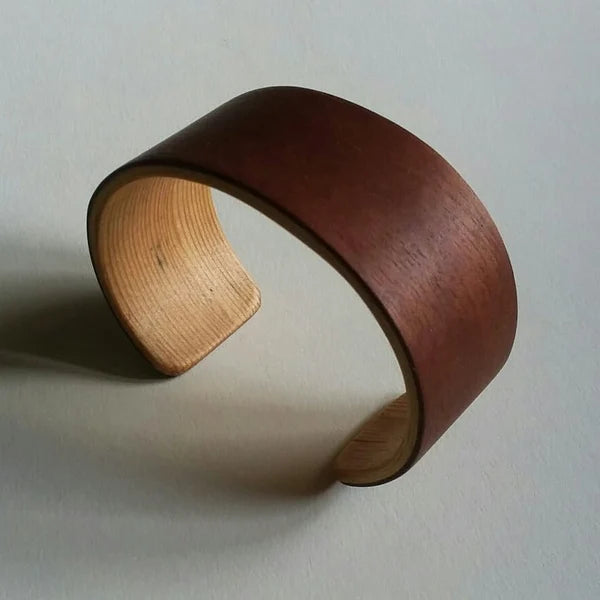Woodworking projects such as crafting a wooden cuff bracelet can be highly satisfying experiences that allow you to combine craftsmanship with personal expression. By using walnut veneer, super glue, and Tru Oil finishes - among other materials - you can transform simple materials into an accessory that expresses both natural beauty and your creative expression. Our guide offers step-by-step instructions that ensure professional results - it makes this project ideal for woodworkers of any experience level or beginner woodworkers looking for new techniques! Creating something timeless yet personalized.
Step 1: Create a Former for the Wood Cuff Bracelet
Wood Cuff Bracelets make perfect accessories to compliment any wrist size or shape - starting from an existing bangle as inspiration or designing your oval template; these form the basis of shaping the bracelet to meet all of its dimensions and requirements. A balanced oval size should measure around 6.5cmx5.5cm for best results.
- Use a pencil to outline your design on scrap wood, taking care to outline it clearly and precisely in order to prevent errors during cutting.
- Use a saw to carefully cut out your shape, following its traced lines with caution and accuracy. This step requires patience and steady hands in order to maintain accuracy and ensure accurate cutting results.
- Once cut, smooth the edges using sandpaper to eliminate splinters and create a sleek edge. This step ensures your wood strips fit tightly while simultaneously protecting you against sharp corners during subsequent steps.
Spending the time to craft an accurate and precise former will make subsequent steps much simpler, leading to a beautifully formed bracelet.

Step 2: Shape and Prepare the Wood for the Cuff Bracelet
Preparing wood veneers correctly for creating flexible and smooth bracelets is crucial in order to achieve them successfully. Walnut veneer is an excellent option due to its rich grain pattern and ability to soften easily under heat, thus making it perfect for shaping into shape.
- Begin by taking measurements around your former to establish the length of wood strips needed. In this project, cut strips measuring 3.5cm wide by 22 cm long in order to cover it completely with some overlap.
- Make strips more malleable and easy to handle by using a sharp blade or sanding tool to slightly thin their edges with an angle grinder, thus decreasing cracking risks when bending wood strips. This step reduces the risk when bending strips.
- Soak the veneer strips for about 30 minutes in boiling water to soften their fibers and enable the wood to flex without splitting or snapping.
Making the bracelet flexible requires taking special care in preparing its foundation - take time and care in softening its veneer evenly before starting this step.

Step 3: Wrap and Dry the Wood for the Cuff Bracelet
Shaping wood can be one of the most rewarding parts of this project. Watching as the veneer transforms into the curves that define a bracelet cuff shape is immensely gratifying and sets up for what will eventually be an exquisite final product.
- Carefully extract softened veneer strips from boiling water using tongs or gloves in order to avoid burns from being too close. Please take special caution, as the strips will still be hot when removed!
- Adhere the veneer quickly around the former by starting at one end and carefully aligning it along its curve. Secure with masking tape so as to achieve even pressure along its entire path.
- Leave the wrapped wood to dry for at least 24 hours so it can retain its new form, and ensure a sturdy bracelet structure once glue has been added.
Proper drying is key to creating an elegant curve that comfortably wraps around the wrist. Prior to proceeding with your design process, be sure to allow enough drying time so there is no chance for warping of wood grain and avoid warped ends that might otherwise occur.
Step 4: Glue the Wood Layers for the Cuff Bracelet
Adhere wood layers together using glue for maximum strength and durability - creating a bracelet that will last years ahead.
- Begin by trimming and sanding the first veneer layer until it fits snuggly around its former. Test-fit this layer to ensure there are no gaps or misalignments.
- Apply a thin line of superglue along the edges of the veneer and wrap it tightly around its former. Make sure the seams align at its center for a professional and seamless appearance.
- Repeat this process for subsequent layers, applying glue evenly and wrapping each with care before firm pressure to ensure they stick tightly and securely together.
At this step, preciseness and patience will be key; uneven layers or gaps could compromise both its appearance and durability. Take your time in aligning each layer firmly so it will last long into its finished state.

Step 5: Remove the Cuff Bracelet from the Former
Once the glue has set and your layers have become secure, it's time to carefully remove your bracelet from its mold. Doing this requires great attention as any mistakes could damage either the bracelet itself or mold and require you to start over from scratch again!
- Use a pencil to mark a 2.5cm wide opening at the back of your bracelet for easy wearing and removal of its cuff. This opening allows for wearer comfort as well as easy removal.
- Carefully utilize a chisel or similar tool to disengage the bracelet from its base material, taking your time so as not to rupture glued layers or break their bonding. Work slowly in order to minimize splitting or cracking during disassembly.
- If any wood becomes attached or damaged during assembly, simply trim its edges or sand it away for smooth surfaces. In more serious instances, however, modification might be required, or different materials might need to be utilized.
Eliminating your bracelet marks an exciting milestone in this process, providing your first glimpse of its designer craftsmanship.
Step 6: Shape and Sand the Wood Cuff Bracelet
Shaping and sanding are crucial steps in crafting an attractive bracelet that fits comfortably on your wrist, turning rough edges into polished finishes that showcase its design. This step transforms rough pieces into refined finished products.
- Use a saw or trimming tool to trim away excess material from the bracelet and refine its edges.
- Start out sanding using coarse-grit sandpaper to form the bracelet's basic form and smooth away any rough surfaces, then progress gradually up to finer grits - up to 600 grit is recommended - until your bracelet reaches a polished and uniform look.
- Make sure that when choosing a bracelet, it provides a comfortable and snug fit. Pay special attention to its interior and edges in order to guarantee this.
Step four is all about detail; a beautifully finished bracelet not only looks lovely but is also more enjoyable to wear than its counterparts.

Step 7: Apply the Finish to Your Wood Cuff Bracelet
Tru Oil is an ideal finishing choice to highlight the inherent charm and safeguard the durability of wood while adding rich tones, creating an ultra-smooth glossy surface finish.
- White spirit should be used to clean off the bracelet after each time it has been used in sanding to eliminate dust or debris that has collected over time.
- Apply a thin coat of Tru Oil Gun Stock Finish using either a cloth or brush, waiting 24 hours between coats before adding another.
- Between coats, lightly sand the surface with wire wool to achieve an ideal surface that's both glossy and durable. Follow this process until all 7 coats have been added for optimal durability and glossiness.
- Complete the finishing process by applying polishing compound and Renaissance Wax as the last steps. These additions add shine while providing extra protection from wear.
Finishing can elevate any bracelet and ensure its beauty and long-term wearability.

Conclusion
Congratulations on creating an exquisite wood cuff bracelet to showcase your artistry and craftsmanship! Your piece combines natural elegance with handmade touches for an irresistibly stunning accessory that is perfect as either a gift or a treasured part of your collection.
This project is not only about creating beautiful jewelry pieces but also about enjoying the process of turning raw materials into wearable art. Experiment with various wood types, shapes and finishes so your bracelet becomes truly one-of-a-kind!
Now is your turn: gather materials, follow these steps and give life to your vision of wood cuff bracelet making. Crafting one yourself can be an engaging journey that ends up with timeless and personal accessories!










